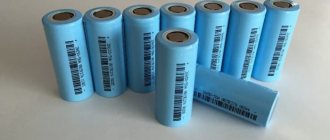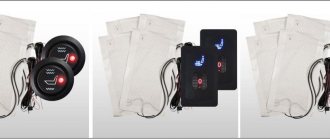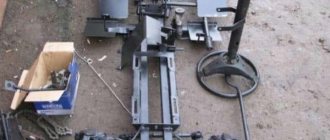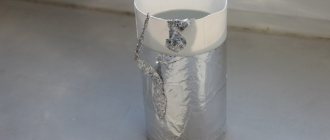The almost complete lack of choice of industrial designs of the “mini” class forces people to take up the manufacture of machines of this class with their own hands.
Although the machines are structurally similar to mini tractors, homemade trucks are still less popular among designers. In part, this may be due to the difficulties of registering such vehicles, in part, it may simply be due to a reluctance to tinker with a home-made truck, but the fact remains that there are not as many examples of home-made trucks as we would like.
Today we will briefly look at two representatives of this segment of home-made equipment: a Russian version and a truck made by a Canadian home-made vehicle.
Homemade mini truck
Fig.1.
Appearance of a homemade mini truck. This mini truck differs from many of its other brethren in its simplicity of design and reliability in operation (its speed is up to 70 km/h). It is quite possible to build it at home.
The spacious, bright cabin with panoramic front glass provides good visibility and protects the driver from bad weather. The rather convenient location of the engine under the car body increases the usable area of the cabin and body.
Overall dimensions of a homemade mini truck:
— Length — 2380 mm, — width — 1210 mm, — height — 1450 mm, — ground clearance — 230 mm, — track width — 960 mm.
Fig.2. Overall dimensions of a homemade mini truck.
The truck has a rectangular welded tubular frame measuring 2380 x 490 mm. In its central part, a two-stroke engine from an IZH-56 motorcycle with a power of 14 hp is installed on two plate brackets. With. (10.3 kW). However, another similar one will do. You never know what “pieces of hardware” have accumulated in home workshops and sheds over the decades!
The front suspension has two shortened semi-elliptic springs (from Volga or Moskvich-407 cars in 2 leaves) with dry mechanical friction-type shock absorbers. The front axle is solid, with steering axles on the axle shafts. The hubs of the front steering wheels rotate on these axle shafts on paired ball bearings.
Fig.3. Front view and rear view (sectional).
Rear suspension - independent, with coil springs and friction-type mechanical shock absorbers
Torque is transmitted to the rear wheels through a gearbox with a differential mechanism and a reverse gear shift unit. Rotation from the engine to the gearbox is transmitted by a roller chain.
The car's brake mechanism is installed only on the rear wheels.
Braking is performed using a foot pedal and a handbrake lever with a parking lock from the driver's cab.
The car's cabin is a two-seater cabin, made of duralumin by riveting.
Cabin height is 1250 mm, width - 1200 mm, length - 1300 mm.
On the left side of the cabin there is a steering wheel, clutch pedal, brake pedal and gas pedal, to the right of the driver there are two handles: gear shift and hand brake. In the front part of the cabin in front of the driver there is an instrument panel on which the ignition switch, light switch, speedometer, gas meter, and ammeter are mounted. There is also a 2-band semiconductor radio receiver.
There is a lamp mounted in the rear wall of the cabin to illuminate the cabin.
At the front, the car is equipped with headlights with low and high beams. Under the headlights there are oblong sidelights - direction indicators.
The electrical equipment of the car is designed for a voltage of 6 V, battery powered, with recharging from the engine generator. The windshield is equipped with a mechanical wiper.
An air intake with a fan for cooling the engine is installed under the cab floor, which is located behind the cab under the car body.
Fig.4,5. The main components of a homemade mini truck. 1 — hand brake, 2 — gear shift knob, 3 — air cleaner, 4 — body mounts, 5 — steering linkage, 6 — muffler, 7 — friction damper, 8 — independent rear axle suspension, 9 — frame, 10 — rear spring suspension, 11 - battery, 12 - IZH-56 engine, 13 - clutch pedal, 14 - steering gear, 15 - hand brake pedal, 16 - engine starting pedal, 17 - gas pedal.
The car body is made of light wood with a duralumin corner edging. It is made in the form of an onboard cargo area with a folding tailgate and a tarpaulin awning. The body is mounted on the frame using four rods inserted into the frame pipes and secured with four locking bolts. For the transportation of liquids or bulk cargo, the loading platform can be replaced by a tank or a self-dumping tray, and for the transportation of people - by a bus-type body.
Under the body, on a bracket welded to the frame, a fuel tank with a capacity of 12 liters is placed, which ensures a vehicle range of over 200 km without refueling.
The wheels for the car are taken from a wheelchair. However, you can also install wheels from scooters on it. The design uses some standard components from a motorized stroller, such as the rear axle, steering and others. This makes building the car much easier.
TRUCK FOR MINI CONSTRUCTION
The bridges are connected to the mounting points on the side members in the same way as on a motorized stroller - with bolts and nuts and split spring washers. After checking the frame for symmetry, absence of distortions and compliance of its dimensions with the drawing, body attachment points and tubular cross members are welded. Two of them, made from a pipe with a diameter of 20 mm, are intended for fastening the seats and the cabin, two, curved from a pipe with a diameter of 30 mm, are the engine motor mount, and one, at the rear of the frame, is the support for the main gear (reverse gearbox). As can be seen from the drawings, the reverse gearbox is installed vertically, with the sprocket (by the way, it is from a cargo scooter) facing up, and the reverse lever is located in front of the vehicle.
Motorized truck body:
1 — side panel (plywood, s12); 2 — tailgate latch; 3 — tailgate hinge; 4 — bracket for the rear light fixtures (steel, sheet s2); 5 — tailgate panel (plywood in 12); 6 — underbody (plywood in 12); 7 — niche lining (steel, sheet s2); 8 — side edging (duralumin, corner 30x30x3); 9 — body base (pine, block 90×40); 10 — M8 mounting bolts with nuts and washers; 11 — half-clamps (steel, strip 40×3); 12 — connecting elements of the body (duralumin, corner 30x30x3); 13 — M5 bolts with nuts
The engine is mounted on the frame by the lower and front units - this is quite enough. The exhaust pipe is standard, from the TG-200M, the muffler is homemade, which is a hollow cylinder, inside of which there is a fine-mesh steel mesh rolled into a tight roll.
The truck body is assembled from 12 mm thick plywood panels. The blanks prepared for assembly are soaked twice with hot drying oil and coated with oil paint in two layers. The body is assembled using duralumin corners 30x30x3 mm and M5 bolts with a countersunk head and nuts. Moreover, at the junctions of the panels, the corners are located both outside the body and inside - this made it possible to obtain a very rigid structure. The edging of the sides is also made of duralumin corners. The base of the body consists of two pine bars with a cross-section of 90×40 mm, secured to the bottom with M6 bolts and nuts. Before installation, the base bars are soaked twice with drying oil and coated with oil paint. In the front part of the body there is a niche for the engine cylinder - it is welded from a steel sheet 2 mm thick and secured to the body with M5 bolts and nuts.
The cabin of the motorized truck is assembled using a technology that is very advantageous for amateur construction. To begin with, a lightweight cabin frame and door frames are welded from thin steel pipes. The frames of the windshield and rear windows are also welded to the frame. By the way, the glass of the rear door of the Moskvich-2141 car was successfully used as a windshield for a motorized truck; part of the same door was used to form the front panel of the cab.
Next, frames were cut out of plywood and secured with soft wire to the frame pipes, after which the space between the frames was filled with blocks of construction foam. At the same time, the shaping of the cabin itself and the doors was carried out as a whole. The surfaces of the cabin are leveled using a long sharp knife, a homemade plane, the piece of iron of which is located at an angle of 45 degrees to its axis, and coarse sandpaper.
After processing the external surfaces, the thickness of the foam filling was increased to 20 mm. To control the thickness of the shell, “beacons” were used - ordinary matches, cut to a length of 20 mm and painted with a felt-tip pen. (“Beacons” are inserted from the outside into the foam flush with the surface of the cabin, and when processing internal surfaces, the material is sequentially selected until the cutter hooks onto the next “beacon.”)
The cabin surfaces prepared in this way were covered with fiberglass - one layer on the inside and three on the outside. After polymerization of the binder, the doors are cut out using a fine-toothed hacksaw, then the doorways and door ends are processed. The inside of the interior is covered with artificial leather.
The driver and passenger seats are homemade: they are tubular frames covered with rubber rings cut from a truck wheel inner tube, foam rubber and artificial leather.
Driving a motorized truck is of an automobile type. The brake system is hydraulic, from the SZD motorized stroller. The throttle and clutch are controlled by cable. The pedal unit (gas-brake-clutch) is mounted on hinge units welded to the frame side members. The gear shift knob is located between the seats, under the driver’s right hand; box drive - using a rigid rod and an intermediate lever. On the right side there is a handle for turning on the reverse (reverse).
The electrical circuit of the car is the same as that of the Ant. From the same scooter are the headlights, direction indicators, speedometer, ignition switch and warning lights.
I. KHOROSHEV, engineer
We recommend reading
- THE MYSTERIES OF CHROME PLATING In “M-K” No. 8 for 1991, material was published on the technology of processing liners for cylinder-piston pairs of modern model engines. Judging by the numerous readers...
- UNFORGETTABLE “FOUR HUNDRED AND EIGHTH”... SOVIET CAR “MOSKVICH-408” MADE IN 1964. Youthful impressions sometimes leave their stereotypes on our entire lives. It’s funny that it was “Moskvich-408” that remained in my mind...
Homemade mini-trucks: diagrams, drawings, tips
A modern “Ant”, assembled according to the drawings of the “Modelist-Constructor” magazine.
Despite the two decades that separate today from the rich Soviet past, the seeds of extraordinary, creative ideas still sprout in the field of modern capitalism and sometimes bear good fruit. Our country inherited homemade trucks as a tradition, because in the modern world, the car and the driver are separated by the most complex mechanical engineering technology, electronics, and numerous and expensive tools. And the products of the Soviet automobile industry pushed the driver to modernize, although not always effective, but with a completely understandable design, practicality of the device, and ease of modernization.
A truck with an IZH engine: from the Volga and Moskvich-407 cars, it is proposed to take semi-elliptical springs, having first shortened them, and make the rear suspension spring, independent.
Just remember the now famous products of the Tula Machine-Building Plant under the unassuming name “Ant”. One type of this wheeled vehicle makes one think about making a flatbed truck based on a scooter. By the way, the first “Ant” (not TG-200) was assembled by hand in 1966 by home-made workers Ivchenko and Molchanov. The Java-350 engine located behind the rear axle made it possible to lower the center of gravity and, together with the carriage layout, make the body more stable on the road. With a power of 14.3 hp. (4500 rpm), this homemade mini-truck developed up to 70 km/h, and its diagrams were published in the “Modelist-Konstruktor” magazine for the 70th year.
And indeed: scrapped mopeds and motorcycles are the basis for most of these crafts. This is probably due to the fact that the design of a moped is easiest to adapt to everyday needs: there is no need to tinker with a complex transmission - you attach the body and go. Homemade mini trucks are assembled not to admire them as a work of art (although this also occurs), but because this type of transport is a wonderful assistant in the household.
Mini truck from a creator from Canada
Not only in our country there are craftsmen who can create a homemade truck from a variety of car parts literally from a landfill.
Mini truck from a creator from Canada
This is exactly what a man from Canada did. His car turned out to be very interesting and original. The engine and gearbox were borrowed for the mini-truck from an old Volkswagen Golf.
The self-made cabin is located above the engine, and the frame is made of square pipes and angles. The frame is covered with thin steel sheets.
Mini truck from a creator from Canada
The American homemade truck has a tipper body; it is lifted using a hydraulic system. It is made of a hydraulic pump and a cylinder. The body can accommodate cargo up to one ton.
General principle
Most often, the base of a homemade mini-truck consists of a welded tubular frame, in the central part of which there is an engine. The motor can be removed from any old motorcycle or moped. The cabin is made from parts of old cars. Since all transmission parts are usually borrowed from other cars, the control levers and pedals are usually located on the right side of the cabin.
Wheels are most often combined (processed machine wheels, with motorcycle wheels or even cart wheels). Masters of such homemade designs for helmsmen recommend using motorcycle and scooter tires. Wheels are selected depending on the driving conditions. Homogeneous and dual wheels are suitable for smooth, unproblematic roads. While wide-profile motorcycle tires are suitable for off-road driving or simply difficult sections of the road.
The homemade truck is driven by an engine from a walk-behind tractor without a muffler, the body is made of lumber, and the wheels are made of low-pressure tires. The disadvantages of the design are front-wheel drive and heavy steel wheels.
The easiest way to assemble a homemade truck body is from lumber: they are inexpensive and do not require any special equipment for installation. Of course, the body can be removed from a tractor or any other vehicle, but you need to take into account its weight and dimensions - such a body is subject to modification. A good welding machine opens up wide possibilities, the presence of which makes it possible to weld a body frame in the garage.
Homemade mini trucks / Trucks and new technologies / cargolink.ru
What are homemade trucks and why are such works of art collected today? We can safely assume that homemade trucks are a way of self-expression, a kind of hobby. This tradition has its roots in the depths of Russian culture. After all, only the Slavs are able to translate unusual creative ideas into reality and serve as the founders of all useful and funny technical revolutions. Most often, such masterpieces are created from old, completely ownerless equipment. Parts can be taken from mopeds, old cars, motorcycles, and even from units that are absolutely not intended for driving.
Modern man, to a greater extent, creates such unusual transport structures not for beauty, but most often only for the benefit of his own household. Time-tested, homemade trucks are the best “helpers” in everyday life, especially when it comes to the agricultural industry. Such homemade devices are used to transport equipment, crops, building materials for various purposes and much more. A homemade truck can transport anything, but the weight and dimensions of possible cargo will depend on the carrying capacity of the vehicle itself.
Frame for a homemade truck
In the general stream of frame structures offered by modern Kulibins, one can distinguish breakable and monolithic frames. The idea of a breakable frame pursues two goals at once - achieving high mobility and combining elements of different cars in one design. So the frame consists of two parts, connected to each other by a hinge. The latter is most often a universal joint removed from another truck. However, such a mount can move in any direction, and its degrees of freedom must first be limited to “right-left” by welding lugs to the edges of the cardan cross.
Homemade trucks created by folk craftsmen
There are more and more modern trucks equipped with the latest science and technology every year, and vehicle models are becoming more diverse. Manufacturers are trying to produce new cars in different price categories.
But there are also real folk craftsmen who, with golden hands, can create a real miracle on wheels, or, to be more precise, home-made trucks. A lot of time and effort is spent on this, but the results are sometimes simply impressive. We will tell our readers about some of the most striking homemade masterpieces.
Engine
As noted above, the main driving force of homemade mini-trucks is motors from mopeds (Soviet magazines recommended using the IZH-56 engine), and low-power boxer engines. The advantage of the latter is the ability to lower the center of gravity and low vibrations, which becomes important when it comes to a heavy body mounted on a passenger chassis. Engines from standard power plants (UD-4, UD-2, etc.) are popular. It is sometimes easier to get diesel and gasoline engines from stations than to recover scrap, but power units from passenger cars are also found in homemade designs.
It is difficult to imagine that a homemade truck will require good dynamics and acceleration. Torque is critical when choosing, but some high-speed engines can be used in conjunction with a reduction gearbox. At low speeds, four-stroke diesel engines demonstrate a good N˙m value. And in the diagrams you can often see ZAZ power units, but what is more important is that they can also often be found on actually working equipment. The durability of these engines, equipped with a good, by the standards of our reality, atmospheric cooling system, is worthy of special mention.
Tractor engines from T-16, T-25, etc. have proven themselves quite well. Motors like the D-21A1 can be easily adapted for domestic needs: power - 25 hp, maximum rpm - 1800. However, the standard starter from these engines may not work Russian cold weather, so the original starter is often replaced with a starter from the T-40. Additionally, the motor can be improved by adding a cardboard filter to it, and given its dimensions, it is better to place it behind the cabin. Engines from the T-16 can be connected to the GAZ-51 gearbox using the original clutch, although in this case you will need to use a sheet metal adapter with holes for the mount and shaft.
Transmission
The wheels on homemade trucks are most often not original ones, so the standard gearbox sometimes cannot provide the required force. A way out of this situation may be to use a rigid box from GAZ (models 53 and 51) together with a low-power engine T-16, M-72, etc. In this case, the truck drawing usually includes an adapter made of a metal plate. The need for such a design arises due to the difference in size of the gearbox input shaft and the crankshaft of the power unit.
The easiest way to use mounted systems is to use homemade or hydraulic ones, and with this there is a need to include a power take-off in the transmission. The selection box can be shared by agricultural machinery or a recycled all-terrain vehicle. Completely remaking bridges is problematic, but by shortening the axle shafts and “stockings” you can change the dimensions of the base and the track size. Seats for axle shafts and bearings can be easily moved to another point in the frame, but this procedure must be accompanied by strengthening the welding site.
The designer's platform is a pure MAN KAT chassis.
Homemade truck from Ryazan
In this design, the author tried to make maximum use of ready-made components and assemblies from industrial designs. The frame, for example, was taken from an old GAZ-51 truck, and all the suspension elements were used from it. The area between the two cross members (and one of them) was cut out, resulting in a frame that was 90 centimeters shorter. The welding area of the frame halves was reinforced with steel plates 4 millimeters thick.
Homemade truck from Ryazan
The positive side of this intervention is that the author did not have to re-mount the springs and the towbar, as he would have had to if he had simply shortened the frame by cutting off its rear part.
Engine and transmission
The machine is equipped with a diesel engine from the T-16 tractor with a power of 16 hp. It is connected to the gearbox (Gas - 51) using the original clutch, for which the designer had to make an adapter from a metal plate with holes for the shaft and fastening. Since the tractor diesel engine is quite low-speed (2600 rpm), the author did not introduce a reduction gearbox into the design.
The cardan has been shortened to match the dimensions of the updated frame. The rear axle is also shortened to reduce the track size. To do this, the stockings were separated from the main gear housing and cut to 88 millimeters, after which grooves were made as on the original and all the parts were reassembled. The axle shafts were also shortened. The front axle from the donor has not undergone any modifications and is installed on a homemade product “as is”.
Cabin and body
The cabin is a combination of serial and home-made elements. The roof, hood, frame and wings of the car are made by hand, and the bumper and radiator trim are taken from a ZIL-130 truck. The windshield is taken from a donor, and the doors are used from an old GAZ-52. The dashboard is GAZ-51, and the seat is GAZ-52. 52. All electrical equipment is powered from the on-board network with a voltage of 12 volts.
The frame of the homemade body is made of rectangular pipes and corners of different sections, and then sheathed with steel sheets 2 millimeters thick. The tailgate folds down, and a tent frame made of wood is installed above the body.
Design
The most logical place to start searching for parts is the axles and engine. The frame, suspension, etc. will depend on the capabilities of the engine and the dimensions of the transmission. In the simplest version, all the parts are simply laid on a flat surface, and the frame is welded based on the distance between the axles. It is recommended to use standard frames from the GAZ-53, which can easily be shortened or equipped with additional cross members, fork bars, shock absorber struts, suspension travel limiters, side members, etc.
It is better, of course, to use preliminary diagrams and drawings. Homemade trucks are assembled from factory parts, so all dimensions must be known, and it is not impossible to write out all the calculations on paper in advance. The standard engine may require modification due to the need to connect to a non-original gearbox; the gearbox does not always allow you to work freely with the wheels and motor at hand, but optimism and preliminary planning help Russian craftsmen cope with any difficulties.











